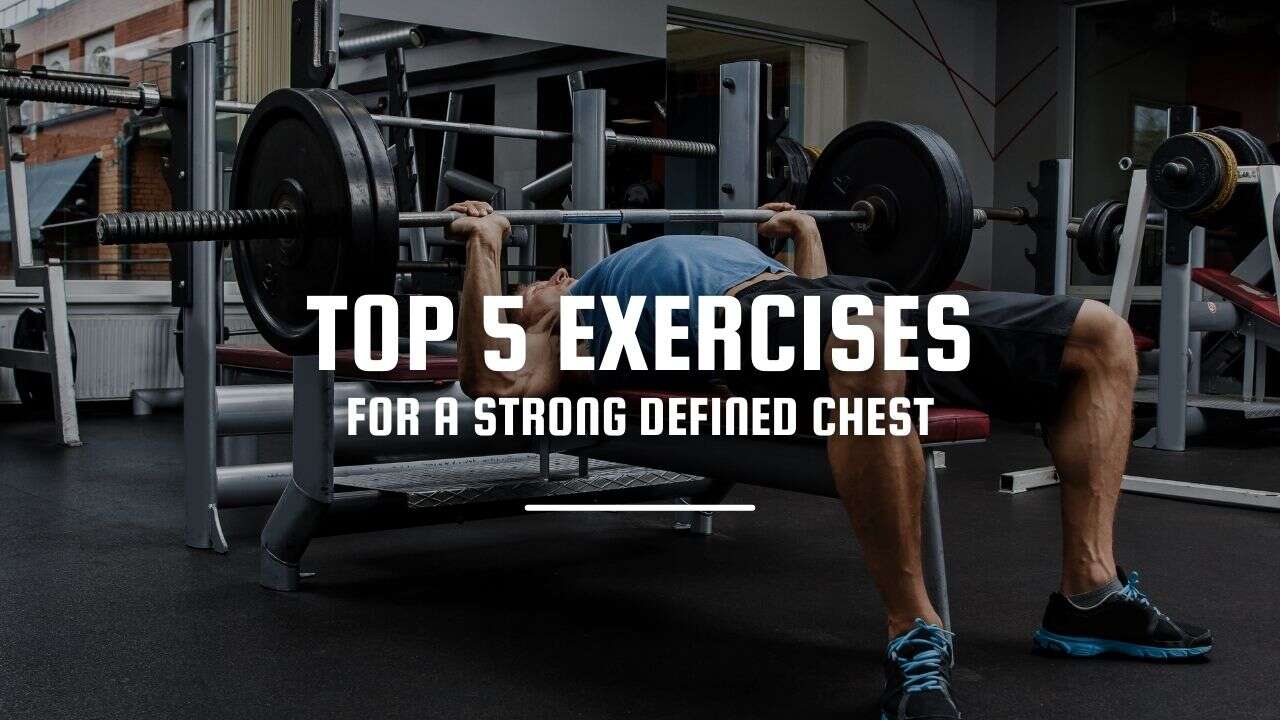💪 TL;DR: Want a Bigger, Stronger Chest? Here’s How to Train It Right
If your goal is a well-developed, muscular chest, it’s time to go beyond bench presses. This guide breaks down the top 5 best chest exercises—from classic pushups to incline dumbbell presses—that build real strength, balance, and definition. You'll learn how to:
- Target upper, middle, and lower chest muscles effectively
- Use dumbbells, machines, and bodyweight for full muscle activation
- Avoid common form mistakes and maximize every rep
- Build a chest day routine that actually delivers visible results
Whether you're training for aesthetics, power, or both—this chest workout strategy will elevate your gains, boost your confidence, and push your performance to the next level.
A well-defined chest isn't just an aesthetic goal for many fitness enthusiasts; it's a testament to strength and balance. Chest exercises are crucial for anyone aiming to build both power and a sculpted upper body. The right routine can transform not only your physique but also your confidence and overall workout performance.
As a fitness trainer, I emphasize the importance of a balanced approach to chest exercises for growth and definition. Incorporating a variety of movements targets different parts of the chest, ensuring comprehensive muscle development and symmetry. Using a combination of classic and innovative exercises allows for impressive strength gains while also defining the chest's contour.
In this article, I'll guide you through the top five chest exercises that cater to growth and definition. From the timeless pushup to the machine chest press, we delve into each with the expertise that ensures effective and safe practice. Let's transform your chest workout routine with proven strategies and targeted exercises.
The Importance of Chest Exercises for Growth and Definition
Building a muscular chest requires a well-rounded approach that stimulates different parts of the pectoral muscles. Effective chest exercises, such as the barbell bench press and incline bench press, are vital for muscle growth and definition. These exercises allow you to move significant weight, promoting muscle mass and stimulating not just the sternal head but also the upper chest fibers.
To achieve a well-developed chest, it is important to activate the upper, middle, and lower portions of the pectoralis major, as well as the pectoralis minor. Incorporating exercises like chest flys and dips can help target these areas, enhancing muscle definition.
Here's a basic exercise list for a balanced chest workout:
- Flat Bench Press
- Incline Dumbbell Bench Press
- Chest Flys
- Dips
Adequate rest, nutrition, and sleep play critical roles in muscle repair and growth. Training your chest 1-2 times per week allows for timely recovery and maximized muscle activation. During each session, keep your feet flat, core tight, and shoulder blades retracted to maintain proper form. Remember, consistency and form are key to achieving those chest gains.
Classic Pushup: The Foundation of Chest Workouts
The classic pushup stands as a cornerstone of chest workouts, employing your own bodyweight to forge a muscular chest. Mastering this exercise involves aligning your posture in a straight line from head to heels, while keeping your core tight for optimal stability. Hands should be positioned just outside your chest, with your feet shoulder-width apart, setting the perfect starting position to maximize muscle engagement.
To boost muscle activation, lower your chest to the floor meticulously and press up with vigor. This explosive movement not only works the chest muscles thoroughly but also engages the core and shoulder blades for a comprehensive workout.
For those seeking a challenge beyond the basic exercise, variations such as the archer pushup offer a unilateral challenge, increasing both difficulty and efficacy. Meanwhile, integrating explosive moves like the plyometric pushup can elevate your chest day, triggering those upper chest fibers and adding to your overall muscle mass.
Remember, consistency in practice fosters well-deserved chest gains, contributing to a well-developed chest. For a balanced workout plan, consider combining classic pushups with exercises like the incline dumbbell bench press at a 45-degree angle, ensuring muscle gain across all facets of the chest.
Dumbbell Bench Press: Building Pectoral Strength
The dumbbell bench press is an essential exercise for developing a well-rounded chest. It allows each side of your chest to work independently, promoting balanced strength and muscle mass. Unlike barbell presses, dumbbells offer a greater range of motion, potentially enhancing muscle growth for those looking to maximize their chest gains.
You can perform these exercises with various grips, adding a new stimulus to your workout routine. Despite some variability, studies show similar muscle activation between flat-bench dumbbell and barbell presses.
Key Variations:
- Neutral-Grip Press: Offers a different angle for targeting muscular chest fibers.
- Close-Grip Press: Ideal for targeting the sternal head of your pecs.
Each variation serves a unique purpose and can be integrated at various points in your workout plan for heavy or high-rep sets.
Quick Tips:
- Keep your feet shoulder-width apart and flat.
- Ensure your shoulder blades are retracted for stability.
- Maintain a core tight position to support your form.
Incorporate these variations into your chest day routine to achieve a well-developed chest. Remember, whether you're at a flat bench or incline position, consistency and form are key to maximizing your chest gains.
Incline Dumbbell Bench Press: Targeting Upper Chest Muscles
The incline dumbbell bench press is a fantastic exercise for targeting the upper chest muscles, particularly the upper chest fibers located just below the clavicle. By setting the weight bench to a 30-degree angle, you maximize engagement of the muscular chest while minimizing stress on the front delts.
This exercise offers the advantage of grip customization. Unlike a barbell, a pair of dumbbells allows you to adjust your grip, ensuring the focus remains on the upper pecs. This can be a more shoulders-friendly alternative compared to the traditional flat bench press.
Key Benefits of Incline Dumbbell Bench Press:
- Targets Upper Chest: The 30-degree angle is ideal for activating the sternal head and upper chest fibers.
- Grip Flexibility: Dumbbells allow for a personalized grip.
- Shoulder-Friendly: Less strain on shoulders compared to flat benching.
Despite its benefits, it's worth noting that the incline dumbbell press might not build muscle mass as efficiently as some other lifts. However, its ability to sculpt a well-developed chest makes it a valuable addition to your chest day workout plan. Remember to keep your feet flat and core tight for optimal performance.
Dumbbell Chest Fly: Enhancing Range of Motion
The Dumbbell Chest Fly is an exceptional exercise for enhancing your chest's range of motion while focusing on muscle gain. With arms slightly bent and held firm, this exercise encourages controlled movement—bringing hands together and then apart without altering the bend in your elbows.
For optimal results, aim for 3 to 4 sets of 12 to 15 repetitions. This not only promotes a well-developed chest but also aids in targeting those upper chest fibers when done correctly at a slight incline.
Here’s a brief on technique:
| Key Points: | Details: |
|---|---|
| Starting Position | Back on weight bench, feet flat, core tight |
| Movement | Bring hands together, arms slightly bent |
| Repetition Range | 12-15 per set |
| Focus on | Control and form |
To further enhance the effectiveness while ensuring shoulder safety, consider the T-Bench Glute Bridge Fly. This variation requires a glute bridge position, keeping your feet shoulder-width apart, engaging both your glutes and abs.
By maintaining a staggered stance with feet firmly on the ground and focusing on proper form, you can maximize your chest gains through this rewarding exercise.
Machine Chest Press: Stability and Controlled Resistance
When it comes to chest exercises, machine chest presses offer unique benefits that should not be overlooked. A key advantage of utilizing machines is the stability and controlled resistance they provide, which allows for heavier lifting without compromising form. This stability ensures a safe range of motion, effectively minimizing the risk of injury compared to free-weight moves.
Another advantage of machine presses is their ability to isolate chest muscles more efficiently by reducing the involvement of stabilizer muscles. This means you can focus directly on the chest, enhancing muscle gain in this area. Machine exercises can be an excellent complement to free-weight routines, especially as the final heavy movement before switching to lighter pump work.
For those aiming to develop a well-rounded chest, variations like the plate-loaded hammer strength machine for decline presses offer multiple options. These variations can specifically target upper chest fibers, making them crucial for building a muscular chest.
Benefits of Machine Chest Press:
- Enhances muscle mass with stabilized lifting.
- Provides a reliable range of motion.
- Focuses directly on chest muscles.
- Complements free-weight exercises effectively.
Incorporating machine chest presses into your workout plan can be a strategic move towards achieving remarkable chest gains.
Conclusion: Crafting the Perfect Chest Workout Routine
Crafting the perfect chest workout routine requires focus on targeting all portions of the chest muscles for balanced development. This includes not only the upper, middle, and lower chest but also the often-overlooked pectoralis minor muscle.
- Core Exercises:
- Barbell Bench Press at a flat bench remains a staple. This basic exercise allows for heavy weight movement, fostering muscle gain and a well-developed chest.
- Incline Dumbbell Bench Press: Set the weight bench to a 45-degree angle to engage the upper chest fibers, enhancing your muscular chest profile.
- Variety in Routine:
- Change exercises every 3-4 weeks to consistently challenge the muscles.
- Use a pair of dumbbells, barbells, and bodyweight exercises to prevent monotony and help with muscle mass.
- Training Frequency:
- Limit chest workouts to 1-2 times per week to allow for muscle recovery, promoting growth without risking overtraining.
Incorporate these elements into your workout plan to build strength, promote muscle adaptation, and achieve optimal chest gains. Keep your core tight, maintain a slight bend in the elbows, and always keep your feet flat or in a staggered stance for stability.



No Comments.